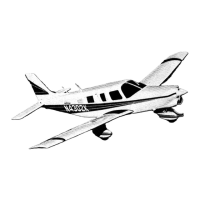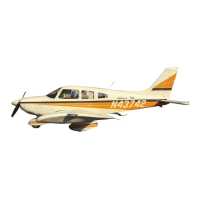3.11 LOSS OF OIL PRESSURE
Loss of oil pressure may be either partial or complete. A partial loss of
oil pressure usually indicates a malfunction in the oil pressure regulating
system, and a landing should be made as soon as possible to allow
investigation of the cause and to prevent engine damage.
A complete loss of oil pressure indication may signify oil exhaustion or
may be the result of a faulty gauge. In either case, proceed toward the
nearest airport, and be prepared for a forced landing. If the problem is not a
pressure gauge malfunction, the engine may stop suddenly. Maintain
altitude until such time as a power off landing can be accomplished. Do not
change power settings unnecessarily, as this may hasten complete power
loss.
Depending on the circumstances, it may be advisable to make an off
airport landing while power is still available, particularly if other indications
of actual oil pressure loss, such as sudden increases in temperatures, or oil
smoke, are apparent, and an airport is not close.
If engine stoppage occurs, proceed with Power Off Landing.
3.13 LOSS OF FUEL PRESSURE
If loss of fuel pressure occurs, turn ON the electric fuel pump and check
that the fuel selector is on a tank containing fuel.
If the problem is not an empty tank, land as soon as practical and have
the engine-driven fuel pump and fuel system checked.
3.15 HIGH OIL TEMPERATURE
An abnormally high oil temperature indication may be caused by a low
oil level, an obstruction in the oil cooling installation, damaged or improper
baffle seals, a defective gauge, or other causes. Land as soon as possible at
an appropriate airport and have the cause investigated.
A steady, rapid rise in oil temperature is a sign of trouble. Land at the
nearest airport and let a mechanic investigate the problem. Watch the oil
pressure gauge for an accompanying loss of pressure.
PIPER AIRCRAFT CORPORATION SECTION 3
PA-38-112, TOMAHAWK EMERGENCY PROCEDURES
ISSUED: JANUARY 20, 1978 REPORT: 2126
3-11
3.11 LOSS OF OIL PRESSURE
Loss of oil pressure may be either partial or complete. A partial loss of
oil pressure usually indicates a malfunction in the oil pressure regulating
system, and a landing should be made as soon as possible to allow
investigation of the cause and to prevent engine damage.
A complete loss of oil pressure indication may signify oil exhaustion or
may be the result of a faulty gauge. In either case, proceed toward the
nearest airport, and be prepared for a forced landing. If the problem is not a
pressure gauge malfunction, the engine may stop suddenly. Maintain
altitude until such time as a power off landing can be accomplished. Do not
change power settings unnecessarily, as this may hasten complete power
loss.
Depending on the circumstances, it may be advisable to make an off
airport landing while power is still available, particularly if other indications
of actual oil pressure loss, such as sudden increases in temperatures, or oil
smoke, are apparent, and an airport is not close.
If engine stoppage occurs, proceed with Power Off Landing.
3.13 LOSS OF FUEL PRESSURE
If loss of fuel pressure occurs, turn ON the electric fuel pump and check
that the fuel selector is on a tank containing fuel.
If the problem is not an empty tank, land as soon as practical and have
the engine-driven fuel pump and fuel system checked.
3.15 HIGH OIL TEMPERATURE
An abnormally high oil temperature indication may be caused by a low
oil level, an obstruction in the oil cooling installation, damaged or improper
baffle seals, a defective gauge, or other causes. Land as soon as possible at
an appropriate airport and have the cause investigated.
A steady, rapid rise in oil temperature is a sign of trouble. Land at the
nearest airport and let a mechanic investigate the problem. Watch the oil
pressure gauge for an accompanying loss of pressure.
PIPER AIRCRAFT CORPORATION SECTION 3
PA-38-112, TOMAHAWK EMERGENCY PROCEDURES
ISSUED: JANUARY 20, 1978 REPORT: 2126
3-11

